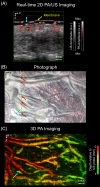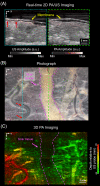Photoacoustic imaging of the human placental vasculature
- PMID: 31661594
- PMCID: PMC8425327
- DOI: 10.1002/jbio.201900167
Photoacoustic imaging of the human placental vasculature
Abstract
Minimally invasive fetal interventions require accurate imaging from inside the uterine cavity. Twin-to-twin transfusion syndrome (TTTS), a condition considered in this study, occurs from abnormal vascular anastomoses in the placenta that allow blood to flow unevenly between the fetuses. Currently, TTTS is treated fetoscopically by identifying the anastomosing vessels, and then performing laser photocoagulation. However, white light fetoscopy provides limited visibility of placental vasculature, which can lead to missed anastomoses or incomplete photocoagulation. Photoacoustic (PA) imaging is an alternative imaging method that provides contrast for hemoglobin, and in this study, two PA systems were used to visualize chorionic (fetal) superficial and subsurface vasculature in human placentas. The first system comprised an optical parametric oscillator for PA excitation and a 2D Fabry-Pérot cavity ultrasound sensor; the second, light emitting diode arrays and a 1D clinical linear-array ultrasound imaging probe. Volumetric photoacoustic images were acquired from ex vivo normal term and TTTS-treated placentas. It was shown that superficial and subsurface branching blood vessels could be visualized to depths of approximately 7 mm, and that ablated tissue yielded negative image contrast. This study demonstrated the strong potential of PA imaging to guide minimally invasive fetal therapies.
Keywords: fetal therapy; human placenta imaging; photoacoustic imaging; twin-to-twin-transfusion syndrome.
© 2019 The Authors. Journal of Biophotonics published by WILEY-VCH Verlag GmbH & Co. KGaA, Weinheim.
Figures






References
-
- Baschat A. A., Hecher K., Semin. Perinatol. 2004, 28, 67. - PubMed
-
- Lewi L., Deprest J., Hecher K., Am. J. Obstet. Gynecol. 2013, 208, 19. - PubMed
-
- Bamberg C., Hecher K., Best Pract. Res. Clin. Obstet. Gynaecol. 2019, 58, 55. - PubMed
-
- Senat M.‐V., Deprest J., Boulvain M., Paupe A., Winer N., Ville Y., N. Engl. J. Med. 2004, 351, 136. - PubMed
Publication types
MeSH terms
Grants and funding
LinkOut - more resources
Full Text Sources

